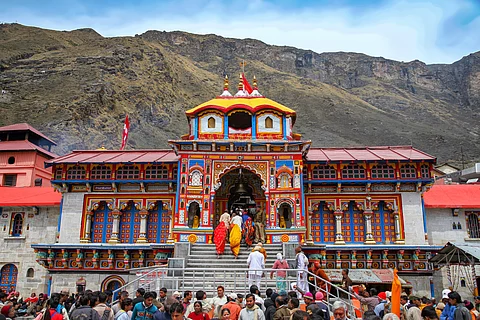
- Destinations
- Experiences
- Stay
- What's new
- Editor’s Picks
- Responsible Tourism
- CampaignsCampaigns
- Subscribe

Badrinath is located at an elevation of around 3,100m in the Garhwal Himalayas, along the banks of the Alaknanda River. The Badrinath Temple, also known as the Badrinarayan Temple, has Lord Vishnu as its presiding deity. The temple is believed to have been established by Adi Shankaracharya in the 8th century.
Here’s what you need to know before you visit this pilgrimage spot.
The Badrinath Temple is open for six months during the year. It opens during the summer season (May) and closes 10 days after Dussehra. This makes the May to October/November window your only chance to visit the holy site. Travelling during the monsoon season from late June to August should be avoided because heavy downpours cause landslides and roadblocks.
Physical currency is a way of life for residents at the Char Dham sites. One would expect the United Payments Interface (UPI) system to be functional here but that is not always the case. Hotels, restaurants and cafés in Badrinath transact via paper notes and coins for the most part. While ATM facilities are available in the town, accessing them among hordes of other tourists also withdrawing cash will be difficult. Bring enough beforehand.
The most comfortable way to reach Kedarnath is by helicopter, palanquin or mules. The walk is long, tiring and difficult for one unaccustomed to doing such treks. Similarly, a helicopter service is also available for Badrinath from the Sahastradhara helipad in Dehradun. A round trip to the temple and back can be accomplished in a day. Check with your tour operator or guide about booking a spot.
Even though Badrinath is warmer during the summer months, it experiences cold and chilly weather throughout the year. Pack sweaters, jackets, thermals, woollen caps, proper footwear and gloves. Carry an umbrella, raincoat and torch in case of sudden showers.
Respect the pilgrimage site and the natural environment by refraining from littering or causing harm to your surroundings. This includes dressing modestly and adhering to the sacred customs and traditions of the place.
The Char Dham trek is physically exhausting which means staying hydrated and energised is important for your wellbeing. Carry packets of dry food, peanuts, dates, chocolates, energy bars and water. Replenish your stores from local markets and water stations where available. Due to its holy nature, alcohol is strictly prohibited in Badrinath and all along the Char Dham route.
